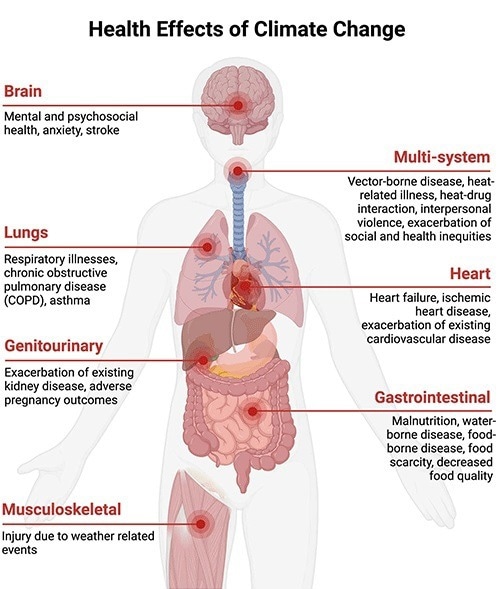The healthcare system is a significant contributor to greenhouse gas emissions. According to a special report published in Radiology, radiology’s involvement within the system offers an opportunity to lead low-carbon, sustainable initiatives in workplaces and communities.

The illustration shows the health effects of climate change grouped according to organ system. Created with BioRender.com. Image Credit: © RSNA 2023
The report highligts the importance of climate change to radiologists and the medical imaging community, including the impact on human health and health equity, the contribution of health care and medical imaging to the climate crisis, and the impetus to build a more sustainable future.
The focus is on actions and opportunities to address climate change in our role as radiologists and to link our actions with their impact and expected outcome. Because radiologists are adept at managing rapid technological change, we are ideally positioned to lead these initiatives within our departments, health care systems, and communities.
Kate Hanneman MD, MPH, Study Senior Author and Associate Professor, Department of Medical Imaging, University of Toronto
Kate Hanneman is also the sustainability lead at University Medical Imaging Toronto.
Climate change is caused by rising levels of carbon dioxide (CO2) and other greenhouse gases in the Earth’s upper atmosphere. The global health care system emits more than 2 gigatons of CO2 equivalent each year due to its huge scale and intense use of resources, accounting for 5-8.5% of total greenhouse gas emissions in developed countries.
While the majority of greenhouse gases emitted by the health care sector are produced during the manufacturing, transportation, use, and disposal of purchased goods, the sources of emissions from individual specialties vary.
The majority of emissions in diagnostic radiology are caused by the manufacture of medical imaging equipment and the energy required to operate it. Medical imaging is predicted to contribute to 1% of world greenhouse gas emissions.
Radiologists Well Positioned to Play Leading Role in Greener Health Care
Although the consequences of climate change have been recognized for decades, health care has been slow to address its significant carbon footprint. However, there is a growing movement to match the environmental practices of health care with its basic aim of minimizing harm and protecting public health.
The harmful health effects of climate change disproportionately impact those already vulnerable due to social, environmental, and public health factors. Groups most likely to be harmed are those already experiencing health inequities due to age, race, culture, sex/gender, socioeconomic status, geographic location, and chronic illness.
Kate Hanneman MD, MPH, Study Senior Author and Associate Professor, Department of Medical Imaging, University of Toronto
As the emphasis on sustainability grows, radiologists are ideally positioned to take the lead in advocating for greener health care. Radiologists, as technology experts, can develop more sustainable methods of care, such as developing novel applications for telemedicine and telecommuting, minimizing energy-intense imaging sequences that provide no clinical value, and scheduling patients more efficiently to reduce equipment idle time.
As key players in the purchasing process, radiologists may prioritize energy efficiency in equipment purchases and collaborate with vendors to promote product sustainability.
The report presents a framework for environmentally sustainable health systems that radiology departments might use.
First, reduce demand for health care services by supporting policies and programs that promote public health, including screening.
Second, match the supply of health services to the demand; for example, by ensuring the appropriate use of imaging. Finally, reduce emissions from the provision of necessary care.
The authors also offer several toolkits that outline some of the actions that organizations, institutions, and individuals can take to help in the fight against climate change.
On the current trajectory of greenhouse gas emissions, climate change will become the defining narrative of human health. Mitigating emissions offers the opportunity for a future in which local and global populations not only survive but thrive.
Kate Hanneman MD, MPH, Study Senior Author and Associate Professor, Department of Medical Imaging, University of Toronto
Journal Reference:
Brown, M., et al. (2023). Climate Change and Radiology: Impetus for Change and a Toolkit for Action. Radiology. doi.org/10.1148/radiol.230229.